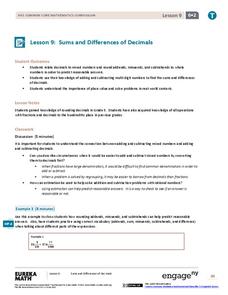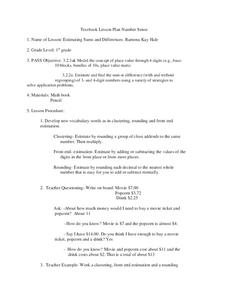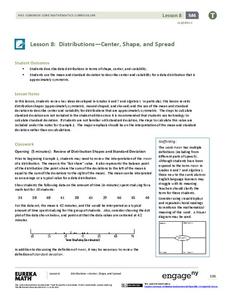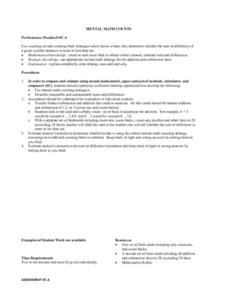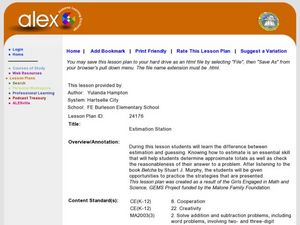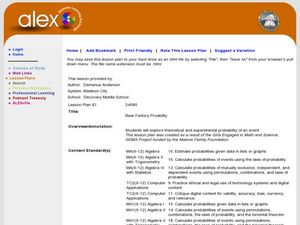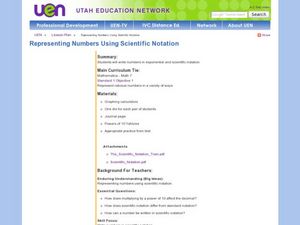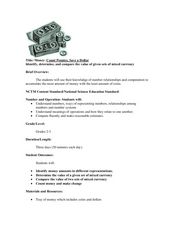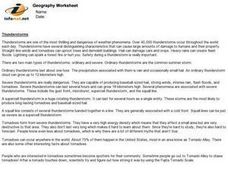EngageNY
Sums and Differences of Decimals
Sometimes dealing with decimals is so much easier than dealing with fractions. The ninth lesson plan in a 21-part module has the class consider situations when it might be easier to add or subtract fractions by first converting to...
Curated OER
Rounding Whole Numbers; Estimating Sums And Differences
In this rounding whole numbers and estimating sums and differences worksheet, students problem solve and calculate the answers to forty two mathematical equations.
Curated OER
Estimating Sums and Differences
In this math worksheet, students learn to estimate sums and differences by completing step by step exercises. There is one word problem which is the example, and then students can choose from other estimation activities to do with a...
Curated OER
Reasonable Estimates
Help pupils explore estimation. They will make estimates and discuss when you might use an estimate. Then they discuss if their estimates are reasonable.
Curated OER
Estimate, Solve, and Check
Young scholars estimate, solve, and check a series of addition and subtraction number and word problems. They write their estimates on a recording sheet, compute and write the answer in the next column, and check their answer with a...
PBS
Estimating Profit from a Job
Profit always seems to get everyone's attention. The same is true during a lesson on estimation. Learners use given information to estimate the cost of supplies for a painting job. They then develop a strategy for estimating the...
For the Teachers
$1 Math
Captivate your class by having them find the value of their names, different zoo animals, musical instruments, etc.,with a mental math lesson. Using the coding formula listed, children learn to fluently estimate and calculate...
Curated OER
Number Sense
First graders practice rounding 4 digit numbers using place value concepts. In this estimating sums and differences lesson, 1st graders explore clustering, rounding, and front end estimation as methods for rounding decimals.
EngageNY
Distributions—Center, Shape, and Spread
Data starts to tell a story when it takes shape. Learners describe skewed and symmetric data. They then use the graphs to estimate mean and standard deviation.
Curated OER
Mental Math Counts
Learners use mental math. They describe reasonable and unreasonable sums and differences. Students use mental math to find the sums and differences of addition and subtraction facts at random. They solve addition and subtraction facts...
Alabama Learning Exchange
Estimation Station: Why Estimating is Better than Guessing
Youngsters discover the difference between estimating and guessing. They estimate how many items are contained in a jar as they read a story. After the story, pupils discover the differences between estimating and guessing and create a...
Curated OER
Estimating and Counting Money
Students explore the concepts of estimating and rounding. In this estimating and rounding instructional activity, students play a game of tic-tac-toe. Students pick items and must estimate their cost by rounding. Students estimate the...
Alabama Learning Exchange
Bear Factory Probability
By examining a set of dice roll data, statisticians determine the probability of different sums occurring. They visit an interactive website and determine how many different vacation outfits Bobbie Bear will have based on the colored...
Curated OER
Solving Problems
Second graders become familiar with need strategies for computation of money problems and estimating sums. In this computation instructional activity, 2nd graders solve real life problems to understand estimation and money problems.
Curated OER
Operations with Fractions and Decimals
Complete a lesson plan that introduces and explores operations with fractions and decimals. Pupils estimate the reasonableness of a decimal computation. Then discuss what operation is needed to find an answer. Handouts, web sources, and...
Curated OER
Representing Numbers Using Scientific Notation
Learners explore the concept of scientific notation. For this scientific notation lesson, mathematicians discuss how multiplying by a power of 10 affects the decimal. They play Powers of 10 Yahtzee. Students roll a die five times and...
Curated OER
Comparison of Two Different Gender Sports Teams - Part 1 of 3 Measures of Central Tendency
Young scholars gather and analyze data from sports teams. In this measures of central tendency lesson, students gather information from websites about sports team performance. Young scholars analyze and draw conclusions from this data....
Rational Number Project
Initial Fraction Ideas Lesson 18: Overview
Develop young mathematicians' ability to compare fractions with investigation into the number 1/2. After brainstorming a list of fractions equivalent to 1/2, children identify a pattern in the numerators and...
Curated OER
Let's Go Shopping: Estimation At The Mall
Students estimate the total cost of a shopping trip. In this estimation instructional activity, students use three different techniques to estimate how much a shopping trip will cost.
Curated OER
Money: Count Pennies, Save a Dollar
Students determine how to make the largest sum of money using the least amount of coins. For this mixed currency lesson, students listen to a reading of If You Made a Million by David M. Schwartz before participating in money counting...
Curated OER
Estimating Solutions to Word Problems
Fourth graders explore number sense by completing word problems in class. In this estimation lesson, 4th graders define terms such as sum, difference, estimate and best. Students complete estimating worksheets based on the concept of...
Curated OER
Estimating With Fractions
Seventh graders, exploring methods to estimate fractions, take notes on estimating fractions, 7th graders write letters to explain the process of estimating fractions and mixed numbers to someone who does not know the concept. Students...
Curated OER
Thunderstorms
Fourth graders examine the attraction between two different charges to investigate lightning in a thunderstorm. They complete an experiment and a worksheet.
Curated OER
Riemann Rectangle Errors
High schoolers calculate the area under a curve. In this calculus instructional activity, students integrate the function to find the area under the curve. They use the Ti to create a visual of the graph.
